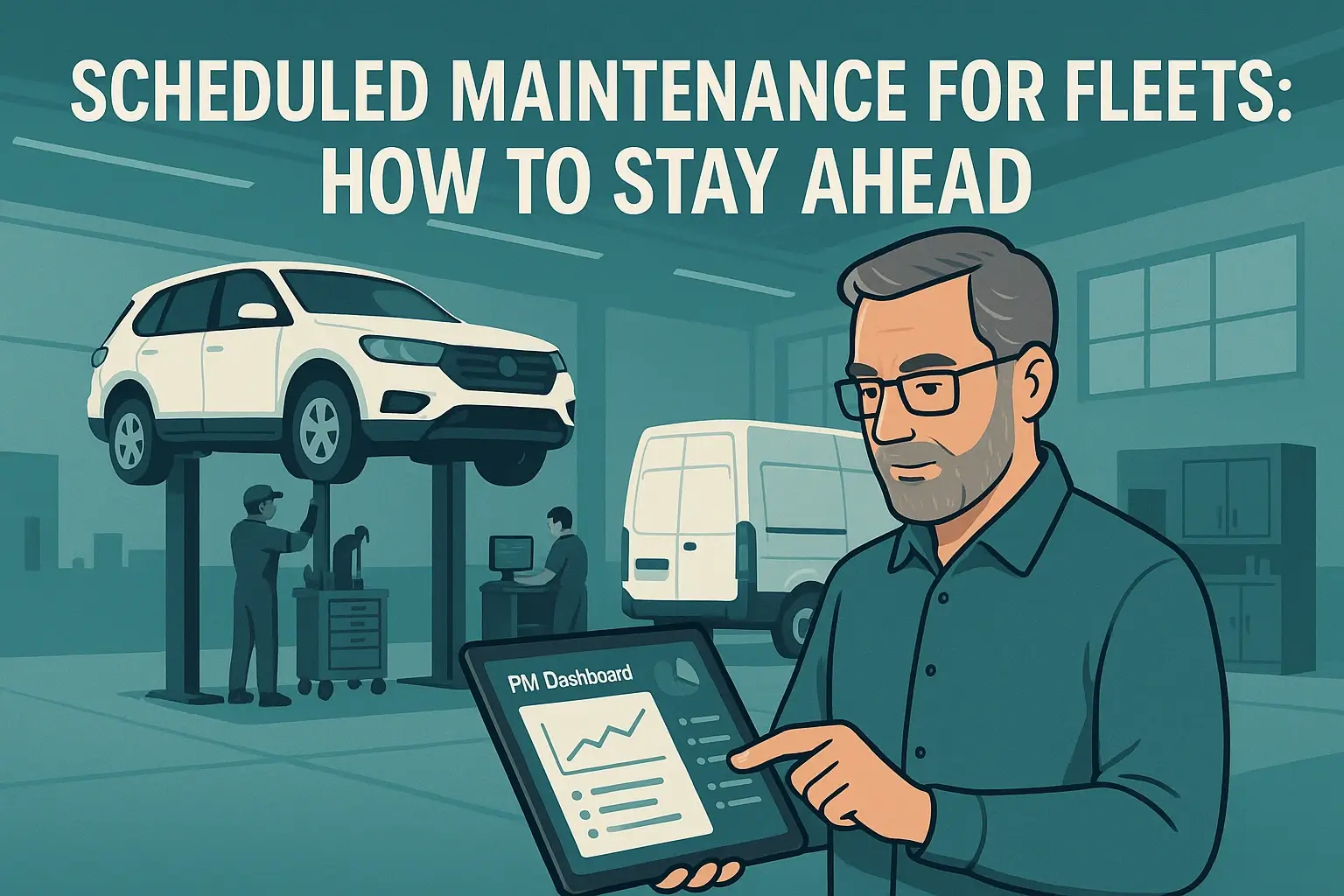Key Takeaways
Fleet maintenance is a critical aspect of managing any transportation business, but it often comes with substantial costs. While it's tempting to look for ways to cut these expenses, it's crucial to ensure that safety is never compromised in the process.
The good news is that there are several strategies you can adopt to reduce fleet maintenance costs while keeping your vehicles—and your drivers—safe on the road.
Here are the top seven ways to achieve this balance.

1. Implement a Preventative Maintenance Program
One of the most effective ways to reduce fleet maintenance costs is to shift from reactive to preventative maintenance. Instead of waiting for something to break down, preventative maintenance involves regularly scheduled inspections and servicing to catch and fix issues before they become serious problems.
How it Works: Preventative maintenance includes routine checks on essential components like brakes, tires, fluids, and the engine. By addressing small issues—like replacing worn-out brake pads or topping off fluids—you can prevent more significant, costlier problems from developing, such as brake failure or engine damage.
Cost Savings: While it might seem like an added expense upfront, preventative maintenance can save money in the long run by avoiding expensive emergency repairs and reducing vehicle downtime.
Safety Benefits: Regular maintenance ensures that all vehicle systems are functioning correctly, reducing the risk of accidents caused by mechanical failures.
2. Use Fleet Management Software
Fleet management software is a powerful tool that can help you monitor and manage various aspects of your fleet, including maintenance schedules, driver behavior, and fuel consumption. This software can automate maintenance reminders, track repair history, and even predict when parts might fail based on data analysis.
How it Works: Fleet management software collects data from your vehicles and drivers, providing you with real-time insights into the health of your fleet. You can use this data to optimize maintenance schedules, track performance, and make informed decisions about vehicle replacements or upgrades.
Cost Savings: By automating maintenance schedules and monitoring vehicle health, you can reduce unnecessary repairs and extend the lifespan of your vehicles. Additionally, the software can help identify underperforming vehicles that are costing more in maintenance than they're worth.
Safety Benefits: The software helps ensure that all vehicles are maintained according to schedule, reducing the risk of accidents due to neglected maintenance.
3. Train Drivers in Safe and Efficient Driving Practices
Driver behavior plays a significant role in vehicle wear and tear. Harsh braking, rapid acceleration, and speeding can all contribute to increased maintenance costs. Training drivers to adopt safer and more efficient driving habits can help reduce the strain on your vehicles and lower overall maintenance expenses.
How it Works: Provide training sessions focused on safe driving practices, such as maintaining a steady speed, avoiding sudden stops and starts, and reducing idle time. Some fleet management systems also offer real-time feedback to drivers, helping them adjust their behavior on the road.
Cost Savings: By driving more smoothly and efficiently, drivers can reduce fuel consumption and extend the life of key vehicle components like brakes and tires, leading to lower maintenance costs.
Safety Benefits: Safe driving practices not only reduce wear and tear on vehicles but also decrease the likelihood of accidents, keeping drivers and other road users safe.
4. Regularly Monitor Tire Pressure and Condition
Tires are one of the most critical components of a vehicle, directly impacting both safety and fuel efficiency. Underinflated or worn-out tires can lead to increased fuel consumption and a higher risk of blowouts or accidents. Regularly monitoring tire pressure and condition is a simple yet effective way to keep maintenance costs in check.
How it Works: Implement a routine tire inspection program where tires are checked for proper inflation, tread depth, and any signs of damage. Many modern vehicles are equipped with tire pressure monitoring systems (TPMS), which can alert drivers when tire pressure is low.
Cost Savings: Properly inflated and well-maintained tires last longer, reducing the frequency of replacements. Additionally, maintaining the correct tire pressure improves fuel efficiency, further lowering operating costs.
Safety Benefits: Keeping tires in good condition reduces the risk of blowouts and improves vehicle handling, especially in adverse weather conditions.
Download Your Free Preventive Fleet Maintenance Checklist
5. Adopt a Predictive Maintenance Approach
Predictive maintenance takes preventative maintenance a step further by using data and analytics to predict when a vehicle or component is likely to fail. This approach allows you to address potential issues before they cause a breakdown, further reducing maintenance costs and downtime.
How it Works: Predictive maintenance relies on data collected from various sensors and telematics devices installed in your vehicles. This data is analyzed to identify patterns and predict when maintenance should be performed.
Cost Savings: By predicting failures before they happen, you can schedule maintenance at convenient times, avoiding costly emergency repairs and minimizing vehicle downtime.
Safety Benefits: Predictive maintenance helps ensure that all vehicle components are functioning correctly, reducing the risk of accidents caused by unexpected failures.
6. Optimize Parts Inventory Management
Maintaining an efficient parts inventory can significantly reduce maintenance costs. By keeping essential parts in stock, you can perform repairs more quickly and avoid the higher costs associated with rush orders or emergency repairs. However, it's also important not to overstock, as unused parts can tie up capital and become obsolete.
How it Works: Use fleet management software to track the parts you use most frequently and ensure you always have them on hand. At the same time, regularly review your inventory to identify slow-moving parts that may not be worth stocking in large quantities.
Cost Savings: Efficient inventory management reduces the need for expensive rush orders and ensures that vehicles spend less time out of service waiting for parts. It also helps you avoid overstocking, freeing up capital for other areas of your business.
Safety Benefits: Having the right parts available when needed ensures that vehicles are repaired promptly and correctly, maintaining their safety and reliability.
7. Schedule Regular Inspections and Audits
Regular inspections and audits of your fleet can help identify potential safety and maintenance issues before they become serious problems. These inspections should cover all aspects of your vehicles, including mechanical systems, safety equipment, and driver logs.
How it Works: Develop a schedule for regular inspections and audits, either performed in-house or by a third-party service. Use the findings from these inspections to address issues proactively and update your maintenance plans accordingly.
Cost Savings: Regular inspections help catch problems early, reducing the need for costly repairs and minimizing vehicle downtime. They also ensure that your vehicles are compliant with safety regulations, avoiding potential fines.
Safety Benefits: Inspections and audits are essential for maintaining the safety and reliability of your fleet. By identifying and addressing issues early, you can prevent accidents and keep your vehicles in top condition.
Related Posts
- How can you lower your fleet fuel cost?
- Increasing Trend of Maintenance Cost for Fleet Vehicles
- Strategy to avoid breakdown maintenance
Optimize Your Fleet Maintenance Today!
Managing fleet maintenance doesn't have to be complicated. With Simply Fleet's Fleet Maintenance Software, you can streamline your entire maintenance process, from scheduling preventative checks to tracking repairs and monitoring vehicle health in real-time.
Our intuitive fleet maintenance system helps you reduce costs, minimize downtime, and ensure the safety of your vehicles and drivers. Whether you're managing a small fleet or a large operation, Simply Fleet gives you the tools to keep your fleet running smoothly and efficiently. Ready to simplify your fleet maintenance? Try Simply Fleet today and see the difference!



.png)








.png)


.png)

.avif)




